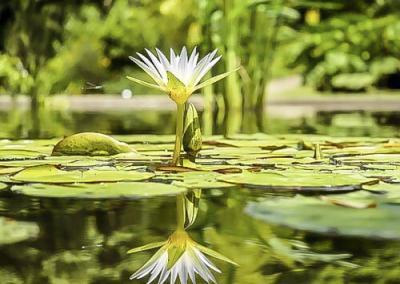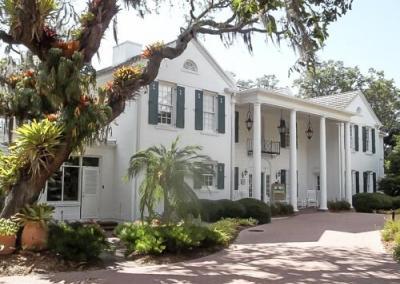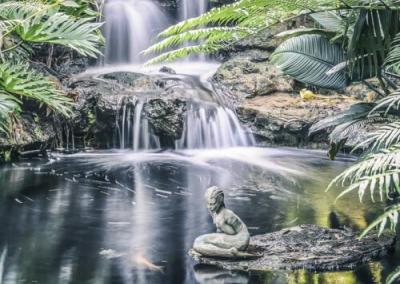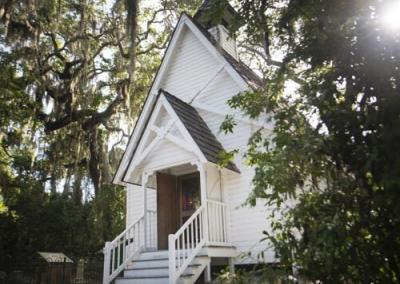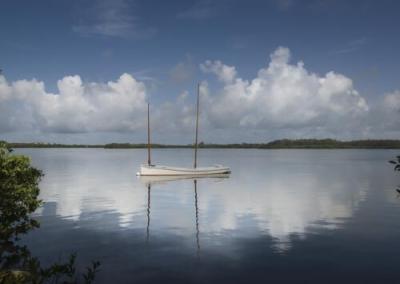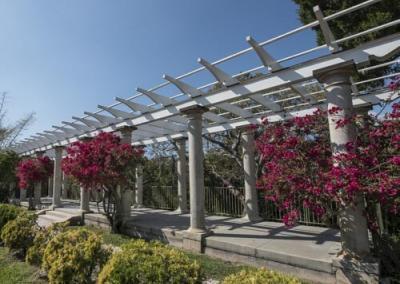Marie Selby Botanical Gardens offers 45 acres of bayfront sanctuaries to explore via two campuses. The Downtown Sarasota campus features 15 acres located along Sarasota Bay where visitors can take in rainforest, desert, native Florida, and display garden areas plus stroll along a bayfront mangrove walkway. Less than 10 miles to the south, the Historic Spanish Point campus features 30 acres situated along Little Sarasota Bay, where visitors can learn about the area’s native and pioneer history and admire a well-preserved collection of native Florida plantings from the site’s nature trails and boardwalks.
Explore Our Gardens
Marie Selby Botanical Gardens’ Downtown Sarasota campus is a bayfront garden oasis made up of many smaller gardens containing plants from our world-renowned living plant collection. The Historic Spanish Point campus features native plants representing more than 50% of the species found in Sarasota County, which can be viewed in different habitats and plant and tree combinations.
Downtown Sarasota Campus
1534 Mound Street
Sarasota, FL 34236
941.366.5731
Historic Spanish Point Campus
401 North Tamiami Trail
Osprey, FL 34229
941.366.5731
Hours
Open daily 10 a.m. – 5 p.m.*
*Closed Christmas Day
Downtown Sarasota Campus
Tropical Conservatory
The conservatory—one of eight greenhouses on site—looks and feels like a tropical rainforest, which is where many of its show-stopping orchids and bromeliads were collected by Selby Gardens’ scientists. The lush, colorful displays change based on which plants are in bloom, providing a different experience on each visit.
Ann Goldstein Children’s Rainforest Garden
This magical play space for children features an elevated garden that gives the sensation of traveling through the treetops. Swinging bridges, an epiphyte canyon, and caves for exploring offer interactive opportunities for learning about rainforest plants, while a 12-foot waterfall adds a soothing soundtrack and delicate mist that enhance the rainforest ambience.
Banyan Grove
Some of these majestic trees were planted by Marie and William Selby nearly a century ago. Their spectacular aerial roots, which grow downward and eventually serve as secondary trunks, allow the trees to spread out laterally. Visitors can often be found exploring, relaxing, or posing for pictures by these fascinating specimens.
Steinwachs Family Foundation Mangrove Walkway
This bayfront boardwalk helps visitors examine the intricate stem and root systems of the red, black, and white mangroves, three species of mangroves native to South Florida that each adapted differently to the challenges of living along the shoreline. Breathtaking views of Sarasota Bay, Bird Key, and downtown Sarasota can also be found here.
Fern Garden
A circular walking trail winds through this peaceful spot, where low-lying ferns serve as a playground for darting lizards, Australian tree ferns tower overhead, and staghorn ferns make their homes in the tree canopy. The area’s subtropical climate allows ferns from the world’s tropics to flourish here.
Bamboo Garden
Nearly a dozen species of tropical clumping bamboos can be observed here, including Giant Bamboo (the largest member of the grass family) that was planted by Marie Selby. Bamboo shoots can grow as much as 40 inches per day during their two-month growth period, and then stay the same size for decades.
Bromeliad Garden
Bromeliads were among the plants that inspired the mission and focus at Selby Gardens, where they’re researched and studied at the Mulford B. Foster Bromeliad Identification Center. Photographers and painters are drawn to this garden filled with layers of colors, shapes, and textures dappled in sunlight and shadows.
Butterfly Garden
Located in front of Payne Mansion, the enchanting Butterfly Garden is visited by dozens of flittering, gliding guests of honor and much loved by children and photographers. The colorful, layered environment was designed specifically to attract butterflies and help reestablish the native butterfly population.
Koi Pond
Young visitors love feeding the hungry, colorful fish that swim around this pond with its gently babbling waterfall. The picturesque spot is surrounded by towering oaks that play host to a variety of air plants, whose vivid colors and intriguing fragrances help attract pollinators and ensure their survival.
Selby House
Built in the early 1920s, this two-story, Spanish-style home was Marie and William Selby’s original residence. Today it houses the Selby House Café, which offers a variety of food and beverages and features several historic photos related to the Selbys and their home.
Museum of Botany & the Arts
Housed in the 1930s-era Payne Mansion, the Museum of Botany & the Arts showcases Selby Gardens’ nature-related art exhibits that are part of its Living Museum model. Past exhibits have focused on artists such as Andy Warhol, Marc Chagall, and Paul Gaugin.
Historic Spanish Point Campus
White Cottage and Sunken Garden
The original structure was built in 1884 by Jack Webb for him and his wife, Emma Andrews Webb, and was later used to house guests of the Webb Winter Resort. Mrs. Bertha Palmer, a wealthy businesswoman from Chicago, expanded the structure and used it as a guest house. Mrs. Palmer’s Pergola and Sunken Garden has spectacular views of Little Sarasota Bay.
Guptill House
The Guptill house was first built in 1901 by Frank and Lizzie Guptill. The three-bedroom home was handcrafted by Frank Guptill and built almost entirely out of Florida yellow pine. Since it was restored in 1989, the Guptill house has been open for guests to view early pioneer home life.
Mary’s Chapel
A reconstruction of the chapel found on the property when John Greene Webb and his family homesteaded there in the late 1800s, Mary’s Chapel features seven stained-glass windows, high ceilings, and a church bell that’s often used to ring in new marriages. It was named after Mary Sherrill, a guest who visited the Webbs’ winter resort and died at a young age.
Duchene Lawn
The Duchene Lawn was first built in 1912 as part of Mrs. Bertha Palmer’s winter estate. Named after the French landscape architect, Achille Duchene, It is a Victorian style garden, featuring a classic portal feature (columns and beam) and Washingtonian and Phoenix palm trees.
Webb Packing House
This waterfront reconstruction of the original packing house on the property shows how citrus and other produce grown by the Webb family was prepared for shipment to markets in Key West and Cedar Key. Shelves of faux oranges let young visitors try their hands at citrus packing. The dock at the packing house provides mooring for the MAGIC and access for boat tour guests.
Cock’s Footbridge
In 1904, Daniel Cock, an innkeeper from Virginia, was living at the Fiddler’s Lodge, a building no longer standing. He built a footbridge that connected his home site to the Webb homestead, post office, and the boat docks on the point. The reconstructed footbridge allows loop tours while providing beautiful views of Webb’s Cove, Little Sarasota Bay, Casey Key, and Siesta Key.
Native Flora
Native plants representing more than 50% of the species found in Sarasota County can be viewed along the nature trails and boardwalks at the Historic Spanish Point campus. The natural ecosystems visitors can experience at this important environmental site include pine flatwoods, oak hammocks, tropical hammocks, and a pristine mangrove shoreline.
Archaic Shell Ring
This is the oldest shell mound on the Historic Spanish Point campus, with radio-carbon dating of 4,500 years before present time. This site is believed to have emerged around a fresh water spring, and is composed of shells discarded from thousands of years of seafood consumption. It is in the form of a horseshoe or ring, and there are only 5-6 similar structures located throughout Florida. It is among the rarest types of mound construction in the southeast U.S. Future archeological investigation of this mound is likely to result in an earlier date of original occupation and could possibly result in the discovery of wooden and fibrous artifacts located below current sea level. Understanding the true age and origins of this mound is likely to provide new insight into rising sea levels witnessed by local Native Americans.
Shell Ridge Midden
This mound feature is a ridge of shell that extends into Little Sarasota Bay forming what is currently referred to as the Point. The time period of this shell-works is approximately 2,000 years before present to 1,000 years before present, so this construction followed the construction of the Archaic Shell Ring. It was upon this mound that the pioneer Webb family established their homestead in 1867. Upon finding human remains on the property, Webb engaged the attention of the Smithsonian Institution, who visited the site as early as 1874. The “Windows to the Past” exhibit allows visitors to walk inside and observe a cross section of the shell ridge and understand the time period in which these ancient people lived.

